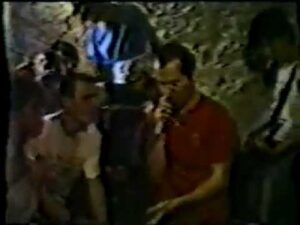Formation & Members
Slapp Happy, not to be confused with the avant-pop group from the 1970s, is a high-energy punk/hardcore band that emerged from the vibrant underground music scene of Tokyo, Japan, in the early 2000s. Formed in 2003, the band consists of four core members: Kenji Nakamura on vocals, Yuki Tanaka on guitar, Hiroshi Yamamoto on bass, and Sara Sato on drums. Each member brought a unique influence to the band, drawing from a mixture of Western punk and traditional Japanese rock influences, which contributed to their distinctive sound.
Kenji Nakamura, known for his charismatic stage presence and raw vocal power, had previously been involved in several local punk acts. Yuki Tanaka’s guitar work is notable for its ferocity and precision, blending fast-paced riffs with melodic undertones. Hiroshi Yamamoto’s bass lines add depth and intensity, while Sara Sato’s drumming is both relentless and intricate. Together, they created a compelling synergy that quickly garnered attention in the local scene.
Musical Style & Characteristics
Slapp Happy’s musical style is a potent mix of punk rock’s aggressive energy and hardcore’s uncompromising intensity. Their sound is characterized by fast tempos, loud and distorted guitars, and shouted vocals. The band often incorporates elements of traditional Japanese music, adding a unique flavor to their compositions that sets them apart from their Western contemporaries.
Lyrically, Slapp Happy addresses themes of social alienation, personal freedom, and political discontent. Their songs often reflect the struggles and frustrations of urban life, resonating with a wide audience who find solace and strength in their music. The band’s ability to convey intense emotion through both their lyrics and musical arrangements is a testament to their artistry and dedication to the punk ethos.
Key Works & Discography
Slapp Happy’s discography is a testament to their evolution as a band and their influence on the punk scene. Their debut album, “Tokyo Riot,” released in 2004, was a raw and energetic introduction that captured the essence of their live performances. The album was well-received, both locally and internationally, cementing their reputation as a force to be reckoned with in the punk community.
In 2007, they released “Urban Decay,” an album that showcased their growth as musicians. It featured more complex song structures and a broader range of influences, from post-punk to experimental noise. This album included standout tracks like “Concrete Jungle” and “Echoes of the City,” which remain fan favorites to this day.
Their third album, “Chaos Theory” (2011), further expanded their sound, incorporating elements of hardcore punk and even hints of metal. This release solidified their status as pioneers of the modern Japanese punk scene. In 2018, the band released “Resurgence,” an album that marked a return to their roots while also exploring new sonic territories.
Influence on Other Bands/Scenes
Slapp Happy has been a significant influence on both the Japanese punk scene and international bands. Their unique blend of traditional Japanese sounds with punk aesthetics has inspired numerous artists to explore similar fusions. They have played a crucial role in bringing Japanese punk to a global audience, often performing alongside well-known Western punk bands and participating in international festivals.
Their influence extends beyond music, as they have also been involved in various social and political causes, using their platform to advocate for change. This aspect of their work has inspired younger bands to adopt a more activist stance, highlighting the power of music as a tool for social transformation.
Breakups or Reunions
Like many bands in the punk genre, Slapp Happy has experienced its share of internal tensions and challenges. In 2012, the band announced an indefinite hiatus due to creative differences and the members’ desire to pursue individual projects. During this time, Kenji Nakamura embarked on a solo career, while Yuki Tanaka and Sara Sato formed a short-lived side project called “Noise Bloom.”
The hiatus lasted until 2016, when the band surprised fans with a reunion announcement. This comeback was marked by a series of sold-out shows in Japan and a successful European tour. The reunion not only reignited their passion for music but also introduced their work to a new generation of fans.
Current Reputation & Legacy
Today, Slapp Happy is regarded as one of the most influential bands in the Japanese punk scene. Their innovative approach to music and commitment to authenticity have earned them a dedicated fan base and critical acclaim. They continue to inspire both established and emerging artists, with their legacy evident in the ongoing popularity of their albums and the continued relevance of their messages.
The band’s live performances are legendary, known for their intensity and the sense of community they foster among audience members. Despite the challenges they have faced, Slapp Happy remains a symbol of resilience and artistic integrity in the punk community.
Conclusion
Slapp Happy’s journey from the underground clubs of Tokyo to international recognition is a testament to their talent and perseverance. Their ability to adapt and evolve while staying true to their roots is a rare quality that has ensured their enduring influence on the punk and hardcore scenes. As they continue to perform and create, Slapp Happy’s impact on the music world is undeniable, leaving a lasting legacy for future generations of musicians and fans alike.









